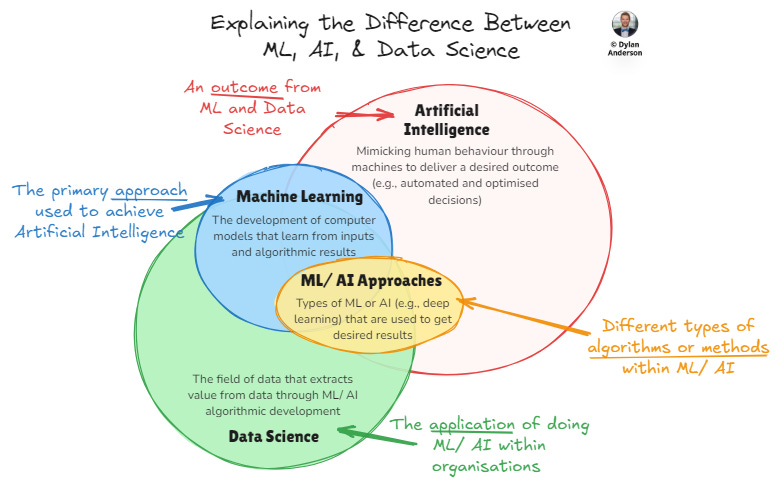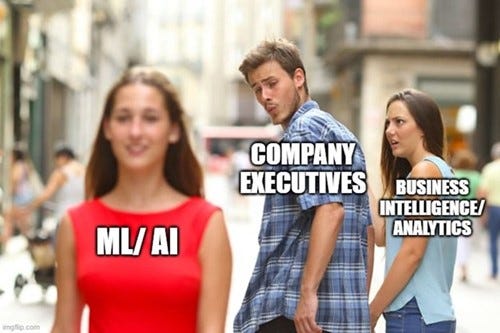Issue #37 – The Basics of Machine Learning & AI
10 minutes to uncover what the hell Machine Learning and AI actually are
Read time: 10 minutes
You hear the same question at every conference, meetup, and business conversation...
"So, what are you doing about AI?"
This question keeps executives and data leaders up at night. The next thing you know, they’ve launched multiple initiatives to make their organisations appear "AI-ready."
The real result? Instead of driving business value, it creates a lot of confusion, wasted investment, and misaligned expectations. Not to mention burnt-out teams, unimpressed shareholders, and barriers to future data progress!
This article has been a long time coming.
AI is the one thing in The Data Ecosystem that everybody is concerned about but nobody really understands it.
GenAI, RAGs, Neural Networks, Deep Learning, AI Agents, LLMs, GANs.
People talk about all these words and acronyms like they're nothing, but do they really understand them? Probably not…
But here's the thing - while the hype cycle is real, the underlying importance of Machine Learning (ML) and Artificial Intelligence (AI) isn't going away. In fact, it's becoming more crucial than ever for business leaders to understand these technologies beyond the buzzwords.
So welcome to the first article in The Data Ecosystem’s Machine Learning & AI six-part series. Time to cut through the noise and get to what matters.
What is Machine Learning & AI?
First things first, let's define these terms in plain English.
Machine Learning – The process of computers using algorithms to make better decisions or predictions by learning from data, ideally improving their performance over time with more data and initial tests/ results.
AI (Artificial Intelligence) – The ability of computers to ‘think’, mimicking human intelligence through algorithms (often leveraging Machine Learning) and behaving in a way that resembles an intelligent human.

The key difference? AI is the broader concept of machines being "smart," while ML is a specific approach to creating AI by teaching computers through data and examples rather than strict rules.
AI has been around since the 1950s, but it's only recently become practical for most businesses. Why? Three things changed:
We finally have enough data to teach computers effectively
Computing power became cheap and accessible
Algorithms got much better at handling complex patterns
Referring back to the definitions of AI, it isn’t an approach, a domain, or a skill.
Instead, Artificial Intelligence is an outcome. It is a state where we, as humans, are able to teach computers to be smart enough to replicate human behaviour.
While AI has existed for decades, the methodology, technology, and foundations have only recently caught up to our ideas, allowing us to realise its potential ‘en masse.’
The Core Components
Now, let’s push past the simple definitions to the more nuanced components of ML & AI that tend to go unnoticed—its underlying components.
Most companies break into ‘AI’ when their executives say: “Let’s do AI”. But it’s not that simple…

Machine Learning and AI is not just a Python script away. It is built up of four key components, each of which has to be operating effectively for ML/ AI to work and to get an output that provides any value:

1) The Data
This is the foundation for success. Most people know this (even executives), but the gap between knowing that data is crucial for ML/ AI and knowing what quality the data needs to be is wide! The popularity of the data quality domain has exploded precisely because of the failure of AI initiatives to produce anything useful. Anything built in ML/ AI will be trained on the data that is being input. If the data is full of errors, the output will be wrong. If the data lacks context to the real world, the output will be wrong. If the data is outdated, the output will be wrong. And you get my drift… Therefore the data needs to be:
Relevant to the use case
Clean and consistent
Tied to business measures/ context
Managed and governed
Up to date
2) Algorithms
The recipe for ML/ AI, teaching the computer and program how to learn. The algorithm finds patterns in the data, makes predictions based on those patterns, and learns from those outputs over time to improve upon. This component is essential, but often it is given more attention than it deserves.
Data scientists spend hours honing and perfecting their scripts to improve accuracy or processing speed, while the company might not invest as much time and effort in the data that feeds the algorithm or researching the relevance of the algorithm to deliver value for the business.
For example, you can have the best recipe in the world, but if the ingredients (i.e., data) are bad, your output will also taste bad. Moreover, if your audience doesn’t want that recipe, you spend all that effort to create something that will just be thrown out.
3) Computing Power/ Infrastructure
The enabler of modern ML/AI that actually makes everything possible. While algorithms have existed for decades, the ability to process massive amounts of data quickly and efficiently has transformed what's actually possible with ML/AI. Going back to the cooking analogy, you may have the best ingredients (data) and recipe (algorithm), but you need the right equipment to carry out the recipe and use the ingredients to make a palatable dish.
We will get more into the infrastructure elements in future articles, but some key components include:
Computing Resources – Processing power that runs calculations (GPUs, CPUs)
Memory – Working space where active data and computations live (RAM)
Storage – Where long-term data (raw and processed) is stored
Networking Components – Systems that connect your infrastructure, enabling data movement and computation
Software Stack – Programs, tools, development environments and ML/ AI frameworks that help run algorithms
4) Human Expertise
The most overlooked yet crucial component
Companies often think investing in technology will solve their problems, but ML/AI initiatives are doomed to fail without the right people. Expertise will point the initiative in the right direction, and without that, resources, time, and money can be spent on fruitless endeavours that do not deliver the value the key sponsor hoped for.
When thinking about this core component, consider:
Translating business problems into technical solutions
Defining use cases for ML/ AI that are realistic, scalable and beneficial
Understanding what data is relevant and is good enough quality
Choose appropriate algorithms for specific use cases
Interpreting and explaining tools or results to stakeholders
Getting buy-in and adoption for the tools
So within these four components, what is the main point you should take away?
Well, it is that ML/AI isn't just about technology or hiring a data scientist.
Just like everything in The Data Ecosystem, it is about bringing together the right mix of elements from across different domains to solve real business problems.
If you skip any of these components, you will be building something that will not be used and may cost you your job.
Common Use Cases in Business
If you believe sales and marketing professionals, everything now is AI-enabled.
In reality, that likely means they are running a regression algorithm somewhere in their analysis. Or they are using ChatGPT tools in the tool’s development.
Okay, maybe I’m being a bit harsh. But I want to make the point that just because AI exists doesn’t mean we should be using it for everything!
Now, if you are a business leader and you want to use ML/AI, what common use cases might you consider? And what value does it deliver?
Here are five examples of common use cases that exist today:
Customer Recommender Engines
What It Does: Analysing past customer actions, demographics, and other input data to predict future behaviour
Real Life Example: Spotify's music recommendations or Netflix's TV show/ movie suggestions
Business Value: Personalised experiences lead to customer retention and engagement on the app/ site, leading to further sales and revenue
Fraud Detection
What It Does: Automate the monitoring of transactions and user behaviour to identify suspicious patterns that might indicate fraudulent activity
Real Life Example: Credit card companies flagging unusual purchases and banks deciding to give people loans or detecting abnormal login patterns
Business Value: Combs through thousands of applications/ transactions would be otherwise impossible to identify questionable scenarios, thereby preventing financial losses and building customer trust by protecting their accounts
Document Processing
What It Does: Automatically extracting and categorizing information from documents, forms, and emails to streamline workflow
Real Life Example: Insurance companies processing claims forms, HR departments scanning resumes for candidate matching, or AI chatbots consolidating information from the web
Business Value: The reduction of manual processing time saves time and money, and, in a lot of ways, improves accuracy, all allowing staff to focus on higher-value tasks
Product Search
What It Does: Improves search results by understanding context, language, and user intent rather than just matching keywords
Real Life Example: Amazon's search engine understands that "running shoes men black" means you want men's black running shoes, even though it's not proper grammar
Business Value: Helps customers find products faster, which increases conversion rates, reduces abandoned searches and leads to improved revenue
Quality Control
What It Does: Using computer vision and sensor data to identify defects or quality issues in manufacturing processes based on thousands of examples of what a defect should look like
Real Life Example: Auto manufacturers using AI-powered cameras to spot paint defects or food producers checking for packaging errors
Business Value: Automates inspection, which is faster, cheaper and more accurate than humans, thereby ensuring quality standards and reducing waste
These use cases are quite generic but demonstrate how versatile ML can be and the time/ money it can save if done properly. However, doing this properly requires extensive context and planning (circling back to the human expertise core component) because even a tool/ algorithm that is slightly off won’t deliver the value end users expect.
Understanding the Value Proposition
I don’t want to finish this first article without warning against rushing to ML/ AI. I’ve written on this topic before, but nobody listened because 80% of AI initiatives still fail.
When does ML/AI make sense? When doesn't it? Let's be practical about this
ML/AI Makes Sense When:
You have a specific, measurable problem to solve
You have enough quality data about the problem
The pattern or decision is too complex for simple rules
The cost of getting it wrong isn't catastrophic
The potential ROI justifies the investment
Common Pitfalls to Avoid:
Implementing AI because competitors are doing it
Starting with technology instead of business problems
Underestimating the data preparation needed
Expecting perfect accuracy
Forgetting about maintenance and updates
ROI Considerations:
Initial investment (technology, talent, data preparation)
Ongoing costs (computing, maintenance, updates)
Expected benefits (cost savings, revenue increase, competitive advantage)
Time to value (how long until you see results)
Risk factors (data privacy, regulatory compliance, model accuracy)
Remember, ML and AI isn’t magic. They are approaches/ tools (ML) and outcomes (AI).
Like any approach, you need to ensure it is framed correctly to get the right output.
Like any outcome, you must be clear about the expectations and invest the right resources or time to make it happen.
In the end, the value of ML and AI comes from solving real problems more efficiently, using data, algorithms, computing power/ infrastructure, and human expertise to deliver the right output.
Next week, we'll dive into the backend foundations of ML/AI. Here, we will dig further into the building blocks that you need to set it up, how it works in practice and the difference between ML and analytics (because, honestly, most people don’t know). Until then, thanks for reading and have a great Sunday!
Thanks for the read! Comment below and share the newsletter/ issue if you think it is relevant! Feel free to also follow me on LinkedIn (very active) or Medium (increasingly active). And if you are interested in consulting, please do reach out. See you amazing folks next week!






There should be a circle around your Venn Diagram called 'Statistics/Mathematics.' Data Science, AI, Deep Learning, and Machine Learning are all branches of very advanced applied statistics, which most people learn in their second or third year of a Statistics, Data Science, or Mathematics undergraduate degree.
As ever. Really beautiful article. Thank you for sharing your pearls of wisdom with such clarity.